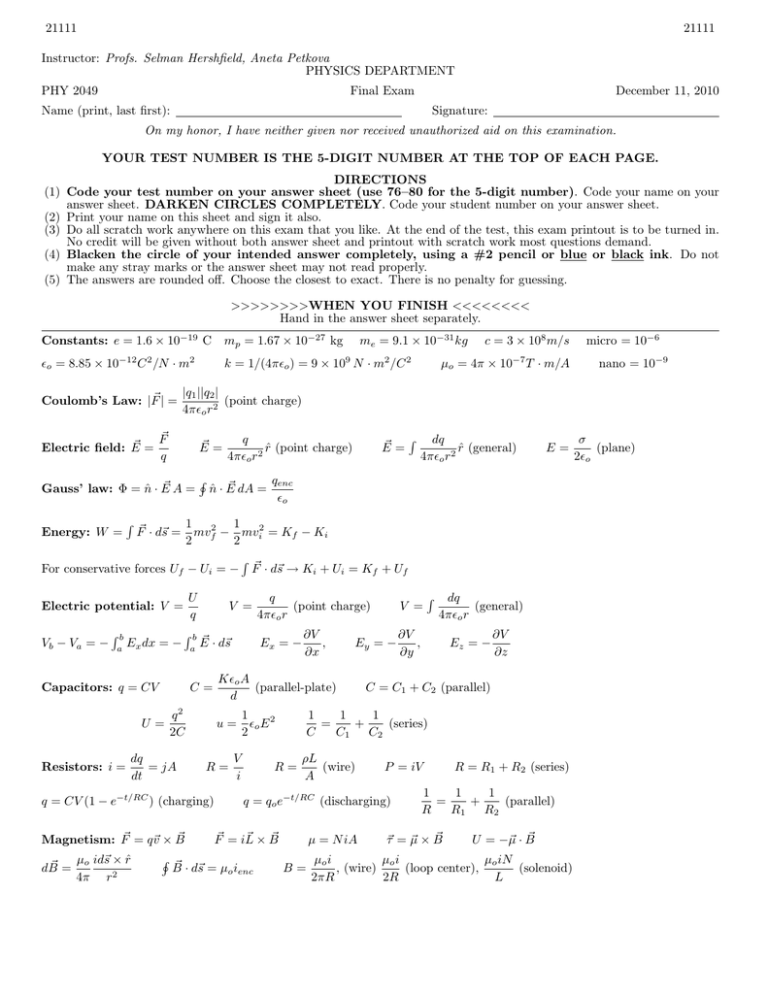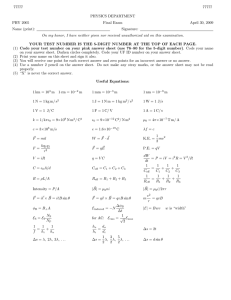21111 Profs. Selman Hershfield, Aneta Petkova PHYSICS DEPARTMENT PHY 2049
advertisement

21111 21111 Instructor: Profs. Selman Hershfield, Aneta Petkova PHYSICS DEPARTMENT PHY 2049 Final Exam December 11, 2010 Name (print, last first): Signature: On my honor, I have neither given nor received unauthorized aid on this examination. YOUR TEST NUMBER IS THE 5-DIGIT NUMBER AT THE TOP OF EACH PAGE. DIRECTIONS (1) Code your test number on your answer sheet (use 76–80 for the 5-digit number). Code your name on your answer sheet. DARKEN CIRCLES COMPLETELY. Code your student number on your answer sheet. (2) Print your name on this sheet and sign it also. (3) Do all scratch work anywhere on this exam that you like. At the end of the test, this exam printout is to be turned in. No credit will be given without both answer sheet and printout with scratch work most questions demand. (4) Blacken the circle of your intended answer completely, using a #2 pencil or blue or black ink. Do not make any stray marks or the answer sheet may not read properly. (5) The answers are rounded off. Choose the closest to exact. There is no penalty for guessing. >>>>>>>>WHEN YOU FINISH <<<<<<<< Hand in the answer sheet separately. Constants: e = 1.6 × 10−19 C mp = 1.67 × 10−27 kg ²o = 8.85 × 10−12 C 2 /N · m2 Coulomb’s Law: |F~ | = me = 9.1 × 10−31 kg k = 1/(4π²o ) = 9 × 109 N · m2 /C 2 c = 3 × 108 m/s µo = 4π × 10−7 T · m/A ~ = E ~A= Gauss’ law: Φ = n̂ · E H q r̂ (point charge) 4π²o r2 ~ = E R dq r̂ (general) 4π²o r2 E= ~ dA = qenc n̂ · E ²o R 1 1 F~ · d~s = mvf2 − mvi2 = Kf − Ki 2 2 R For conservative forces Uf − Ui = − F~ · d~s → Ki + Ui = Kf + Uf Electric potential: V = Vb − Va = − Rb a Ex dx = − U q Rb Capacitors: q = CV U= Resistors: i = a V = ~ · d~s E C= q2 2C dq = jA dt nano = 10−9 |q1 ||q2 | (point charge) 4π²o r2 ~ ~ =F Electric field: E q Energy: W = micro = 10−6 V = ∂V , ∂x ∂V , ∂y Ex = − Ey = − K²o A (parallel-plate) d u= R= q = CV (1 − e−t/RC ) (charging) q (point charge) 4π²o r V i 1 ²o E 2 2 R= R dq (general) 4π²o r Ez = − ∂V ∂z C = C1 + C2 (parallel) 1 1 1 = + (series) C C1 C2 ρL (wire) A P = iV q = qo e−t/RC (discharging) R = R1 + R2 (series) 1 1 1 = + (parallel) R R1 R2 ~ ~ ×B ~ ~ ~ Magnetism: F~ = q~v × B F~ = iL µ = N iA ~τ = µ ~ ×B U = −~ µ·B H µo i µo i µo iN ~ · d~s = µo ienc ~ = µo id~s × r̂ B B= , (wire) (loop center), (solenoid) dB 2 4π r 2πR 2R L σ (plane) 2²o 21111 21111 L = N ΦB /i (definition) UB = 1 2 Li 2 uB = B2 2µo AC Circuits: ω = √ tan φ = H i= I= Em Z q = Qo e−Rt/(2L) cos(ω 0 t + φ) First 2 Maxwell’s Eqs.: Last 2 Maxwell’s Eqs.: EM Waves: c = I = Io cos2 θ E= E (1 − e−t/τL ) R H Z= 1 1 1 2 + = = p i f r i = io e−t/τL E = Em sin(ωt) p E1 = −M τL = L R R2 + (XL − XC )2 H ~ · n̂dA = qenc E ²0 ~ · n̂dA = 0 B H XL = ωL, θc = sin−1 ~ =B ~ m sin(~k · ~r − ωt) B pr = Interference: ∆L = mλn (constructive) 1 1 1 = + (parallel) L L1 L2 Pavg = 1 IEm cos φ 2 1 di , vL = L , ωC dt vC = q C 1 2 E cµo rms n2 θB = tan−1 n1 I = Savg = n2 n1 ~m ⊥ B ~ m ⊥ ~k E p= id = ²o dΦE dt Em Erms = √ 2 I= Ps 4πr2 c = ω/k = f λ U (mom. carried by EM radiation of energy U ) c 1 1 1 1 1 + = = (n − 1)( − ) p i f r1 r2 ∆L = (m + 21 )λn (destructive) m=− λn = λ/n i p n = 1 in air ∆L = d sin(θ) (2-slit), 2L1 − 2L2 (interferometer), 2t (thin film) with extra λ/2 when reflecting off higher index Diffraction: d sin(θ) = mλ (grating) cos φ = ~ · d~s = −N dΦB E dt 2I (total reflection) c n1 n2 n2 − n1 + = p i r L = L1 + L2 (series) Vs Ns = Vp Np XC = ~ · d~s = µo ²o dΦE + µo ienc B dt ~= 1E ~ ×B ~ S µo di2 dt i = I sin(ωt − φ) (driven RLC) ¡ ¢1/2 ω 0 = ω 2 − (R/(2L))2 n1 sin θ1 = n2 sin θ2 I (total absorption) c Images: H E 1 =√ B µo ²o ~ =E ~ m sin(~k · ~r − ωt) E pr = ~ dA n̂ · B 1 (LC circuit) LC XL − XC R H ~ · d~s = − dΦB E dt di L = µo n2 Al (solenoid) E = −L dt ~A= Induction: ΦB = n̂ · B 2d sin(θ) = mλ (X-ray) sin θ = 1.22λ/d (aperture) R Z 21111 21111 1. Charges are arranged on a square of side 3 cm as shown in the figure. If Q = 2.3 × 10−7 C, how much work is required to move a charge of −2Q from infinity to the center of the square? (1) 0 J (2) 0.40 J (3) 0.0012 J (4) -0.13 J (5) 0.12 J 2. If the voltage across the entire capacitor network at right is 5.0 V, what is the charge on the 12µF capacitor? (1) 120µC (2) 15µC (3) 60µC (4) 25µC (5) 45µC 3. A current of 3 A flows into a capacitor with circular plates of radius R = 5 mm. What is the magnitude of the magnetic field at point P in between the plates at a radial distance r = 4 mm from the center of the plates? (1) 15 × 10−5 T (2) 11 × 10−5 T (3) 9.6 × 10−5 T (4) 12 × 10−5 T (5) 7.7 × 10−5 T 4. A current i = 2A flows in a long straight wire and in a circular loop as indicated in the figure. If the distance a = 3 cm, what is the magnitude of the magnetic field at point P at the center of the loop? (1) 35µT (2) 55µT (3) 14µT (4) 49µT (5) 29µT 5. Light is incident perpendicularly on a thin layer of material 2 that lies between materials 1 and 3. The waves of rays r1 and r2 interfere. (The rays are tilted only for clarity.) The indexes of refraction are n1 = 1.0, n2 = 1.6, and n3 = 1.8, and the thickness of layer 2 is 200 nm. What is the wavelength of the incoming light (in media 1) in the visible region, 400nm ≤ λ ≤ 700nm, for which there is completely destructive interference? (1) 430 nm (2) 640 nm (3) 560 nm (4) 480 nm (5) 400 nm 6. A concave mirror has a radius of curvature of R = 2 m. An object is placed 1.25 m in front of the mirror. Is the image real or virtual, upright or inverted, larger or smaller than the object? (1) (2) (3) (4) (5) real, upright, larger virtual, upright, larger virtual, inverted, larger virtual, upright, smaller real, inverted, larger 21111 21111 7. A point charge lies at the center of two concentric conducting shells, as shown in the figure. What is the surface charge density of the outer surface of the largest shell? (1) (2) (3) (4) (5) -2nC 2nC -3nC m 2 0µC/m −12µC/m2 −16µC/m2 −8µC/m2 −47µC/m2 m 4.5 8. A circular loop of wire in the plane of the page has radius 3 cm and resistance 0.5 Ω. A uniform magnetic field coming out of the page has time dependence B(t) = (2 − 0.2t), where B is measured in Tesla and t is measured in seconds. At t = 0 what is the magnitude and direction of the induced current in the loop? (1) (2) (3) (4) (5) 10 mA, counterclockwise 1 mA, clockwise 10 mA, clockwise 100 mA, clockwise 1 mA, counterclockwise 9. A wire segment of length L has constant linear charge density λ > 0. Which of the following expressions gives the magnitude of the electric field a distance D from the center of the wire (see figure)? Z Z L/2 kDλ dx 2 2 2 −L/2 (x + D ) Z L/2 kxλ (5) dx 2 + D 2 )3/2 (x −L/2 (1) (2) Z L/2 kxλ dx 2 2 2 −L/2 (x + D ) (3) Z L/2 kλ dx 2 2 −L/2 (x + D ) (4) L/2 −L/2 (x 2 kDλ dx + D2 )3/2 10. Unpolarized light of intensity Io is sent through three polarizers. Polarizer 1 has an axis of polarization of θ1 = 0◦ , and polarizer 3 has an axis of polarization of θ3 = 30◦ . If no light is transmitted, i.e. the final intensity is zero, what are all the possible values of the polarization axis for the second polarizer, θ2 ? (1) (2) (3) (4) (5) 60◦ and 90◦ 90◦ and 120◦ 90◦ only 120◦ only 60◦ only 11. Visible light is incident perpendicular to a grating with 400 rulings/mm. What is the longest wavelength that can be seen in the fourth-order (n = 4) diffraction pattern? (1) 550 nm (2) 400 nm (3) 500 nm (4) 675 nm (5) 625 nm 12. Visible light of wavelength 400 nm (blue) passes through two narrow slits of separation 20 µm. What is the distance between the central maximum and an adjacent maximum on a screen placed 8 meters away? (1) 16 cm (2) 8 cm (3) 4 cm (4) 32 cm (5) 2 cm 21111 21111 13. Three wires with (nonzero) current flowing perpendicular to the page are spaced equally on a line as shown in the figure. The first wire experiences no force due to the other two wires when: (1) i2 = 2i3 (2) i1 + i2 = i3 (3) i1 = i2 = i3 (4) the force on i1 can not be zero (5) i3 = 2i2 14. Three identical light bulbs are placed in a circuit as shown at right. Light bulb C is removed, resulting in an open circuit where C was originally. What happens to the brightness of light bulbs A and B? (1) (2) (3) (4) (5) The brightness of the bulbs does not change. Bulb B becomes dimmer, and bulb A becomes brighter. Bulbs A and B both become brighter. Bulb A becomes dimmer, and bulb B becomes brighter. Bulbs A and B both become dimmer. 15. Four charges are arranged as shown in the figure. Each charge is 8 cm from the origin. The values of the charges are Q1 = +3µC, Q2 = +1µC, Q3 = +1µC, and Q4 = −1µC. What is the magnitude of the force on a fifth charge of 2µC placed at the origin? (1) 13 N (2) 8 N (3) 11 N (4) 4 N (5) 17 N 16. Estimate the linear separation of two objects that the human eye can resolve at a distance of 1 meter. Take the diameter of the pupil to be 5 mm, and the wavelength of the light to be 420 nm. (1) 1 mm (2) 0.1 mm (3) 10 µm (4) 1 cm (5) 1 µm 17. What is the magnitude and direction of the current in the circuit at right? (1) (2) (3) (4) (5) 1.0 1.5 1.0 0.5 0.5 A, A, A, A, A, clockwise clockwise counterclockwise counterclockwise clockwise 18. Two converging lenses each with focal length 6 cm are placed on the x-axis at x = 0 cm and x = 12 cm. An object is placed at x = −30 cm. What is the x position of the final image for light going through the two lenses? (1) +42 cm (2) +18 cm (3) −18 cm (4) +30 cm (5) −6 cm 19. A copper wire has a resistivity of 1.69 × 10−8 Ω · m. The wire has a circular cross-section with a diameter of 0.255 mm, which corresponds to 30 gauge wire. How long a piece of wire would you need in order for it to have a resistance of 10Ω? (1) 3 cm (2) 30 cm (3) 3 m (4) 300 m 20. If graph 2 at right is the voltage across the capacitor as a function of time in an RLC series circuit, which graph represents current through the resistor? (1) (2) (3) (4) (5) graph 2 graph 1 graph 3 none of the graphs graph 4 (5) 30 m

